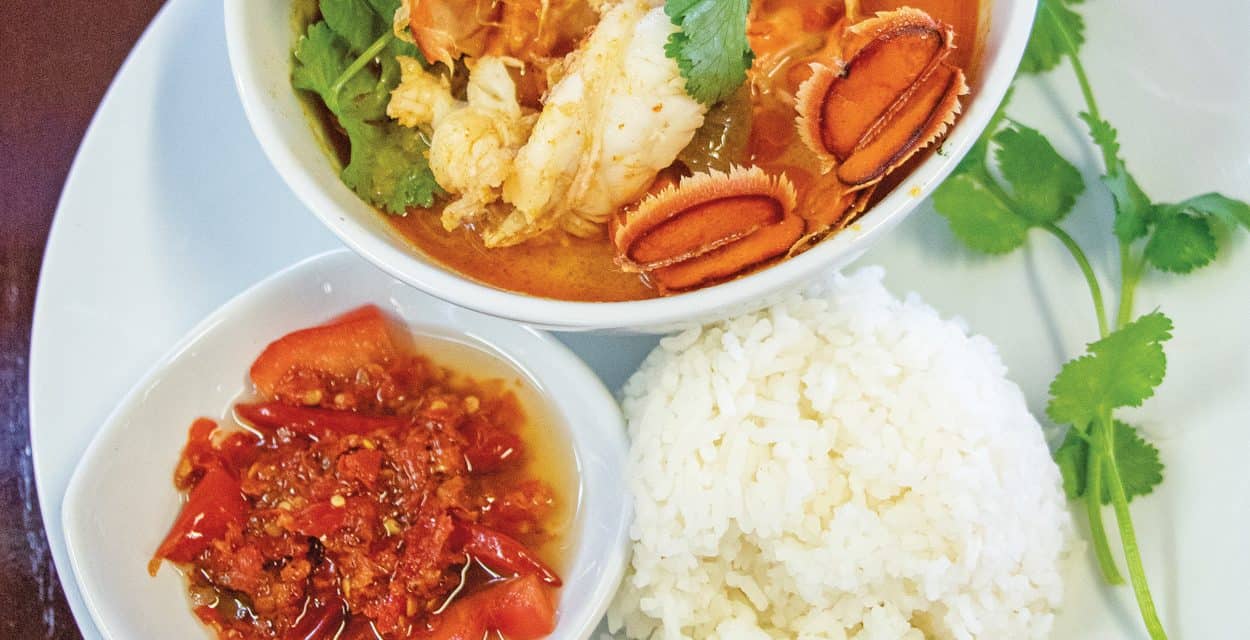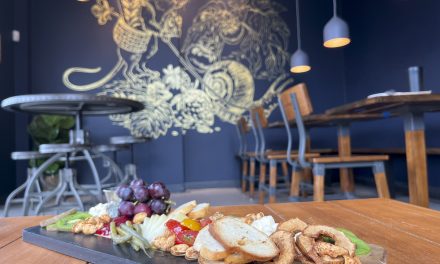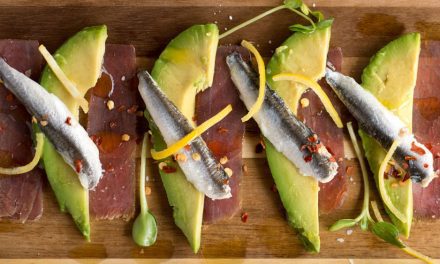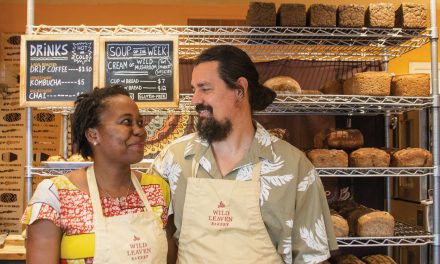Interview and Photos by Stephanie Cameron


Turmeric noodles.
Chef Kimnath Gyallay-Pap, who goes by Chef Nath, calls her fare “inspired Khmer.” It’s a melding of her multiethnic heritage, blending Chinese, Thai, Vietnamese, and her native Cambodian cuisine.
Born in Cambodia, Chef Nath grew up surrounded by Khmer (ethnic Cambodian) cooking. Her Thai great-grandmother had been a restaurateur, and her Vietnamese grandmother cooked for festivals in Buddhist temples.
Now Chef Nath brings her inspired Khmer cuisine to CHOMP, the new food hall in Santa Fe. She is the first food vendor to serve out of what will soon be many stalls offering diverse cuisines. I sat down with her in late March to talk about her new venture and learn a bit more about her story.
You have successfully been doing pop-ups and private catering for the last several years; why did you choose to be a part of the CHOMP food hall? Are you still offering private catering?
I am going on sixty this year, and I saw this as a sweet spot where I don’t have to take on the responsibility and overhead of opening a restaurant. CHOMP allows me to continue to share my food with Santa Feans in a more manageable capacity. It also gives me a kitchen to work out of to continue to do my private catering, allowing me to continue to be able to offer Santa Fe my twist of Khmer food. I am doing a merging of my private catering menu to offer less expensive options during the day for lunch, like tom yum and pad thai. At night, you will find more of the items I provide through my catering, including lemongrass turmeric salmon and red curry chicken.
How has the landscape for Asian cuisine changed in the Southwest over the past twenty years?
Twenty years ago when I lived in Crestone, Colorado, a small town, I was the only Asian gig in town. When I came to the United States, there were many Vietnamese, Chinese, and Thai restaurants, but not many Laos/Cambodian restaurants. So it was a value add for me to do Khmer cuisine in Crestone. Twenty years later, this remains the same, and especially in the Southwest. I want to continue to bring that cuisine to Santa Fe.
What is Khmer cuisine? How is it different from other cuisines in your family?
Cambodian cuisine is different from Thai cuisine because Thai food is usually spicy and has a lot of heat. Vietnamese is more fresh cuisine and uses a lot of raw ingredients. Cambodian is mild, but it is very much inspired by Thai and Vietnamese cuisine.
Are there any ingredients that are unique to Khmer cuisine?
Yes, tamarind and palm sugar. Many Asian cuisines use MSG, but in Cambodian cuisine, we use palm sugar instead. Most of my food uses tamarind. I make pad thai with tamarind instead of lime.
How did you source ingredients when you first began cooking in Crestone? What are some of the key ingredients in your cooking? Has it become easier to source those things in general?
Whenever my family and I travel to Cambodia, we bring back ingredients. When we go to Cambodia, we go to the tamarind trees; we harvest the tamarind and peel and dry it. We brought over a hundred kilograms back on our last trip there, and I still have a good supply. Organic star anise, coriander, and other spices are more accessible to source here. I don’t buy palm sugar from Asian markets here because it isn’t pure, so I use coconut sugar instead. CHOMP is helping me to find more wholesale suppliers now that I am cooking on a larger scale.
In your early life you studied child psychology and were a teacher; what drew you to cooking?
In 1979, after Khmer Rouge, I trained as a preschool teacher and studied psychology for two years—I worked in the education department until 1991, when I met my husband. We moved to the United States in 1999, and when I arrived I didn’t know what to do because I had to have a certificate to teach here.
Before you left Cambodia, a woman called Auntie taught you to make your first curry, and you continued your education during regular trips back to your homeland. Tell us more about how this influenced you as a cook.
In 1986, I met Chef Auntie at the market. She had worked in the royal palace before the Khmer Rouge regime. She wanted to know why, as a woman, I didn’t know how to cook. I told her I didn’t want to learn to cook.
When my husband and I married, I still didn’t cook. I would get food from different restaurants until one day, I saw that they were deep-frying the chicken instead of steaming it, which I didn’t think was right, and I was spending too much money on restaurant food. I wanted my husband to eat better than he had as a single man, so I sought out Auntie’s instruction. For my husband, I wanted to share love through the food. Before I left Cambodia, Auntie taught me to make my first curry, and my education continued during regular trips back to Cambodia.
Auntie took me in as a student because she had lost all her children during the Khmer Rouge campaign. When she took me in, she told me never to tell of or share her recipes. Eventually, Auntie passed away when a thief robbed and killed her.

Tom yum with lobster tail.
How often did you go back to Cambodia to study with Auntie?
Almost every year, I would go back until my father passed away, and then I could no longer visit Cambodia.
What was the moment that made you turn to cooking professionally?
When I arrived in Crestone, I used my husband’s cookbooks to continue to teach myself. I wanted to cook well so that my family and I could eat well, and then I started cooking for my community. When I took a trip to Cambodia to meet with Auntie again, she asked me to make her my curry. She threw it all in the garbage can. She said, “You might be able to fool most Americans, they will eat anything, but for the well traveled, they will not be fooled.”
I learned the basics from Auntie and then learned to change the dishes and make them my own. My cooking draws on my Vietnamese and Chinese roots as well as my Khmer roots. My customers say my pad thai is not pad thai because it uses different ingredients—but they also say it’s better.
Is there anything else you want to share with edible readers?
I don’t care about being a five-star restaurant. The thing I care about is healthy, quality food made with care. I love to see people healthy. When they finish their food, I feel like I have added merit to their lives. The same food you will eat at a private dining event with me, you will experience at CHOMP.
This interview was edited for length and clarity.
CHOMP is located at 505 Cerrillos in Santa Fe.
chefnath.com
Edible celebrates New Mexico's food culture, season by season. We believe that knowing where our food comes from is a powerful thing. With our high-quality, aesthetically pleasing and informative publication, we inspire readers to support and celebrate the growers, producers, chefs, beverage and food artisans, and other food professionals in our community.

















